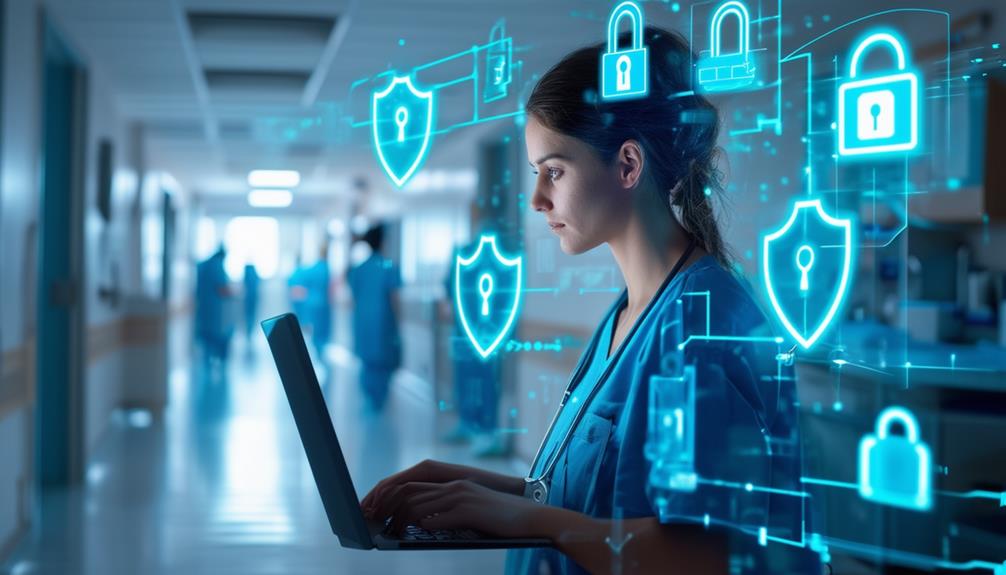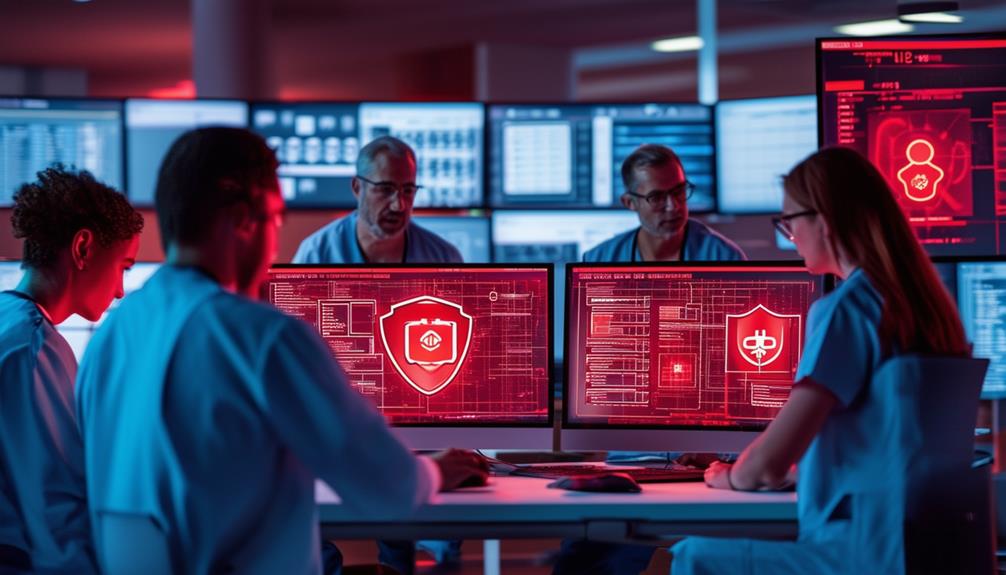Cybersecurity threats in healthcare are escalating rapidly, and the stakes couldn't be higher. Protecting sensitive patient information, ensuring seamless operations, and preserving your organization's reputation are paramount. This multifaceted challenge demands a proactive stance, but where do you begin?
Start with robust employee training to foster a security-first culture. It's not just about technology; your team is your first line of defense.
Next, develop a solid incident response plan to swiftly address breaches when they occur. Each of these elements is vital to your overall strategy.
By prioritizing these areas, you'll create a resilient framework that can adapt to emerging threats. Your approach to healthcare cybersecurity can make all the difference in safeguarding your organization and the patients you serve.
Key Takeaways
- Implement robust access control measures including multi-factor authentication and role-based access control.
- Conduct regular employee training on cybersecurity topics and social engineering tactics.
- Prioritize regular software updates, including medical devices, to address vulnerabilities.
- Utilize end-to-end encryption for patient data and maintain regular, tested backups.
- Develop and practice a comprehensive incident response plan with clear roles and procedures.
Employee Training and Awareness

Through thorough employee training and awareness programs, healthcare organizations can greatly bolster their cybersecurity defenses.
You'll need to implement regular, extensive training sessions that cover various aspects of cybersecurity. Focus on teaching staff to identify phishing emails, create strong passwords, and understand the importance of data protection.
You should also educate employees about social engineering tactics and how to safeguard sensitive patient information. Incorporate real-world examples and interactive scenarios to make the training more engaging and memorable.
Don't forget to address proper use of mobile devices and remote access protocols, as these are common weak points in healthcare cybersecurity.
Establish a culture of cybersecurity awareness by encouraging employees to report suspicious activities and rewarding vigilance.
You'll want to keep your staff updated on the latest threats and best practices through regular communications and refresher courses.
Consider implementing a cyber hygiene checklist for daily use and conduct periodic simulated attacks to test employee readiness.
Robust Access Control Measures

Healthcare organizations' data security hinges on robust access control measures. You must implement multi-factor authentication (MFA) for all user accounts, especially those with access to sensitive patient data. This extra layer of security greatly reduces the risk of unauthorized access, even if passwords are compromised.
Role-based access control (RBAC) is essential. Assign permissions based on job functions, ensuring employees can only access information necessary for their roles. Regularly review and update these permissions as staff roles change or employees leave the organization.
Implement strong password policies, requiring complex passwords that are changed periodically. Consider using password managers to help staff maintain unique, strong passwords for each system they access.
Monitor and log all access attempts, both successful and failed. Set up alerts for suspicious activities, such as multiple failed login attempts or access from unusual locations. Regularly audit these logs to identify potential security breaches or policy violations.
Utilize network segmentation to isolate critical systems and sensitive data from the general network. This approach limits the potential damage if a breach occurs, containing the threat to specific segments.
Regular Software Updates

In light of the ever-evolving cybersecurity landscape, regular software updates are essential for healthcare organizations. You must prioritize these updates to protect patient data and maintain the integrity of your systems. By consistently applying patches and upgrades, you'll address known vulnerabilities and strengthen your defenses against potential cyber threats.
Establish a systematic approach to software updates. Create an inventory of all software and devices in use, and implement a schedule for regular checks and updates.
Don't forget to include medical devices, as they're often overlooked but can be significant weak points in your security infrastructure.
Automate updates whenever possible to guarantee timely implementation and reduce the risk of human error. However, be cautious with critical systems; test updates in a controlled environment before full deployment to prevent disruptions to patient care.
Train your staff on the importance of software updates and how to properly install them. Encourage them to report any unusual system behavior that may indicate a need for immediate patching.
Data Encryption and Backup

While software updates fortify your systems, data encryption and backup form the bedrock of your cybersecurity strategy.
Encryption guarantees that even if unauthorized parties access your data, they can't decipher it. Implement end-to-end encryption for all sensitive patient information, both at rest and in transit. This includes using secure protocols like HTTPS for web traffic and VPNs for remote access.
Don't neglect your backup strategy. Regular, thorough backups protect you against data loss from cyberattacks, hardware failures, or human error. Adopt the 3-2-1 rule: maintain three copies of your data, store them on two different types of media, and keep one copy off-site.
Automate your backup process to guarantee consistency and reduce human error.
Test your encryption and backup systems regularly. Conduct simulated data breaches to verify that your encryption holds up under pressure. Similarly, perform periodic restore tests to guarantee your backups are functional and complete.
Incident Response Planning

Three key components form the foundation of effective incident response planning: preparation, detection, and containment.
In the preparation phase, you'll need to develop a detailed plan that outlines roles, responsibilities, and procedures for responding to various cyber incidents. This plan should include step-by-step instructions for different scenarios, such as data breaches, ransomware attacks, or system failures.
For detection, implement robust monitoring systems and train your staff to recognize potential threats. You'll want to establish clear protocols for reporting suspicious activities and set up automated alerts for unusual network behavior.
Containment involves quickly isolating affected systems to prevent further damage. You should have predefined procedures for disconnecting compromised devices, revoking access credentials, and activating backup systems.
It's essential to practice your incident response plan regularly through simulations and tabletop exercises.
Don't forget to include a communication strategy in your plan. You'll need to inform patients, staff, and regulatory bodies about the incident while maintaining transparency and complying with legal requirements.
After resolving the incident, conduct a thorough post-mortem analysis to identify lessons learned and improve your response for future threats.
Conclusion
You've now got a solid foundation for protecting your healthcare organization from cyber threats. Remember, it's not just about technology—your staff plays an essential role too. Stay vigilant, keep your systems updated, and always have a backup plan. By implementing these strategies, you'll create a robust defense against cybercriminals. Don't forget, cybersecurity is an ongoing process. Stay informed, adapt to new threats, and you'll keep your patients' data safe and secure.

